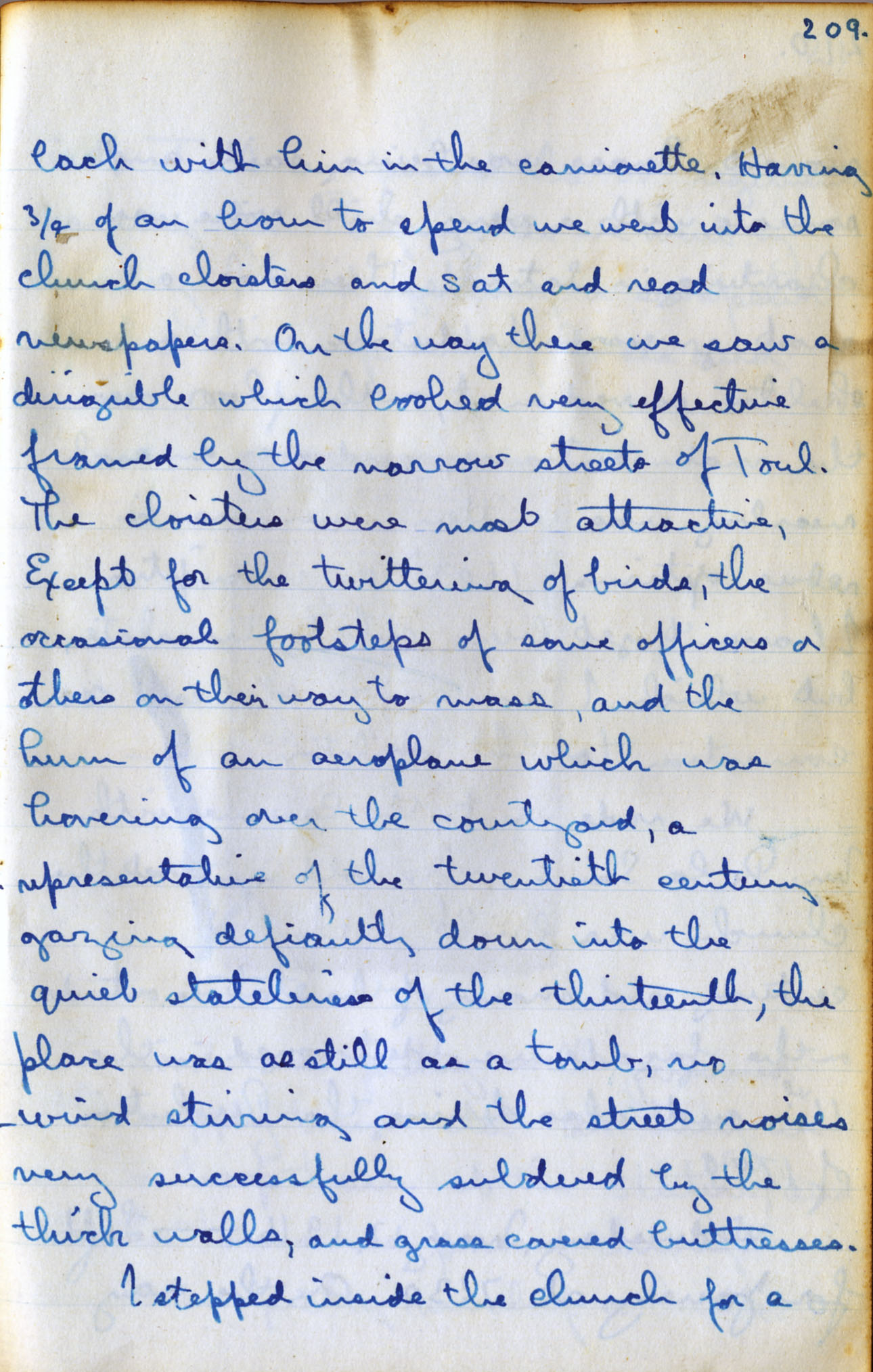| |
Tuesday, May 16th, 1916
Rantoul arrived late last night around the dim of Davis’ snoring
I wish something could be done for the latter, because of course he
can’t help it. Complete repose for Sewall and I today. Tried starting
my car again with the usual luck. Finally success – oiled her
all up in preparation for the journey tomorrow. Sat in dormitory. Sun
appeared in afternoon and tempted Sewall, Pike + me to take a walk.
Rantoul has had his car taken away from in heir of being sent to prison
for absenting himself without leave. He must drive the cammionette for
a week. Think of our hero driving a meat wagon! It ain’t right
Cuthbert!
Our walk took us through Toul and out along the canal by the aerodrome
where there was a balloon ascension going on, and which we photographed
from across the Jansselle.
We wandered along the canal which was most fascinating. It is the Canal
de l’Est (29). Soon we staunch off the
tow path, crossed a little field and watched the railroad track. We
didn’t see a sentinel and chatted a while with the switchman who
was quite surprised that the guard hadn’t stopped us, as he said
it was defended to cross just there. We hurried away before the sentinel
should return, and made our way up a little came to the aviation grounds.
Here we watched the machines for a while and then decided to be bold
and go inside. We walked in and with great brass strode up to the commandant
and with our best salute and in our best French we asked if we could
look around a little. The result was that a young officer showed us
around, and it was very interesting. There were I should think twenty
planes of different sorts scattered around this great open field which
was surrounded on two sides by larger “hangars” containing
perhaps 30 more planes. He showed us a viewport machine, capable of
doing 150 kilometers per hour which had two quite (navel notes) painted
on it. One was just above the rotary, on the hood and read “Si
il pars a Berlin” (30) It is quite evident
what this means but I can’t quite make out what language it is
supposed to be written in. The other notes, painted on the body was
evidently quip on the common “Taisez-vous, mefier vous etc,”
and read “Taisez-vous, maifier-vous (31).”
The other type of machine was the Farman which could attain a speed
of 120 kilometers per hour. This machine has an upright engine as differing
from the rotary engine of the nine cylinders on the viewport. We strolled
away after urging the officer to come to the Cassenne and see us all
someday, which he promised to do. We went back to Toul by a new road,
on which we passed a single 186 and reached the tea shop without further
events. The tea and ice were much as usual. De la Saine came in and
suggested that we go back with him in the camnionette. Having three
quarters of an hour to spend we went into the church cloisters and sat
and read newspapers. On the way there we saw a diagoble (32)
which looked very effective framed by the narrow streets of Toul. The
cloisters were most attractive, except for the twittering of birds,
the occasional footsteps of some officers and others on their way to
mass, and the hum of an aero plane which was hovering over a courtyard,
a representative of the twentieth century grazing defiantly down into
the quiet state lines of the thirteenth, the place was still as a tomb,
no winds stirring, no the street noises very successfully subdued by
the thick walls, and grass covered buttresses.
I stepped inside the church for a moment. Mass was being said, and someone
with a very shill voice was chanting in Latin. There was a most gruesome
tombstone with a skeleton carved on it, on the floor near the main entrance,
and over on such nearby was written “neusura in nebus optima 1603”
(33) an inscription I haven’t yet been
able to translate but which I am convinced bears no connection to the
skeleton.
We made it up to the Cassenne with M. De la Saine who told me that the
church was built in the 13th century and many of the statues outside
on the façade were destroyed in the 16th and also during the
revolution of 1789.
|
